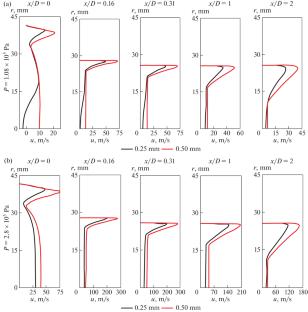沿康达面注入径向射流时轴对称通道内流动结构的数值研究
IF 0.6
4区 工程技术
Q4 MECHANICS
引用次数: 0
摘要
给出了沿康达面注入环形径向射流的通道内流动的数值研究结果。为了描述气体介质的流动,将二维轴对称reynolds -average Navier-Stokes (RANS)方程与半经验k -ω SST湍流模型方程结合使用。研究了总压和径向射流宽度对速度和静压分布的影响,描述了射流在亚临界和超临界压力下局部结构的变化。本文章由计算机程序翻译,如有差异,请以英文原文为准。

Numerical Study of Flow Structure in an Axisymmetric Channel with Injection of a Radial Jet along the Coanda Surface
The results of numerical study of the flow in a channel with an annular radial jet injected along the Coanda surface are given. To describe the flow of the gas medium, the two-dimensional axisymmetric Reynolds-averaged Navier-Stokes (RANS) equations are used in combination with equations of the semi-empirical k–ω SST turbulence model. The effect of the total pressure and the width of radial jet on the velocity and static pressure distributions is studied and changes in the local structure developed at the sub- and supercritical pressure in the jet are described.
求助全文
通过发布文献求助,成功后即可免费获取论文全文。
去求助
来源期刊

Fluid Dynamics
MECHANICS-PHYSICS, FLUIDS & PLASMAS
CiteScore
1.30
自引率
22.20%
发文量
61
审稿时长
6-12 weeks
期刊介绍:
Fluid Dynamics is an international peer reviewed journal that publishes theoretical, computational, and experimental research on aeromechanics, hydrodynamics, plasma dynamics, underground hydrodynamics, and biomechanics of continuous media. Special attention is given to new trends developing at the leading edge of science, such as theory and application of multi-phase flows, chemically reactive flows, liquid and gas flows in electromagnetic fields, new hydrodynamical methods of increasing oil output, new approaches to the description of turbulent flows, etc.
 求助内容:
求助内容: 应助结果提醒方式:
应助结果提醒方式:


